Community Needs Assessment Process
Community Needs Assessment Process
Community Needs Assessment Process
You also want an ePaper? Increase the reach of your titles
YUMPU automatically turns print PDFs into web optimized ePapers that Google loves.
Peoples’ expectations and opinions are considered as an important indication of<br />
possible goals and to possible directions that can influence peoples’ actions and in<br />
result steer the future.<br />
Futures Wheel<br />
The method is a form of structured brainstorming that aims at identifying and packaging<br />
secondary and tertiary consequences of trends and events. A trend or event is placed in<br />
the middle of a piece of paper and then small spokes are drawn wheel-like from the<br />
centre. Primary impacts and consequences are written in circles of the first ring.<br />
Then secondary consequences of each primary impact are derived forming the second<br />
ring. This ripple effect continues until there is a clear picture of implications that the<br />
event or trend can have. Futures wheel is a very simple but powerful technique for<br />
drawing out people's opinions and ideas. However, it is sensitive to underlying<br />
assumptions.<br />
Relevance Tree<br />
It is an analytical technique that subdivides a large subject into increasingly smaller<br />
subtopics. The relevance tree has a form of a hierarchical structure that begins with a<br />
high level of abstraction and moves down with greater degree of detail in the following<br />
levels of the tree. It is a powerful technique that helps to ensure that a given problem or<br />
issue is broken into comprehensive detail and that important connections among the<br />
elements considered are presented in both current and potential situations.<br />
Simulation and Modelling<br />
Simulation and modelling are computer-based tools developed to represent reality.<br />
They are widely used to analyse behaviours and to understand processes. Models allow<br />
demonstration of past changes as well as the examination of various transformations<br />
and their impact on each other and other considered factors.<br />
They can help to understand the connections between factors and events and to<br />
examine their dynamics. Simulation is a process that represents a structure and change<br />
of a system. In simulation some aspects of reality are duplicated or reproduced, usually<br />
within the model. The main purpose of simulation is to discern what would really happen<br />
in the real world if certain conditions, imitated by the model, developed.<br />
Although modelling and simulation became even more popular with the development of<br />
computing technology, application of these techniques have certain limits. Models<br />
represent a simplification of a system that is being examined; therefore the results need<br />
to be carefully considered.<br />
Page 98 of 137

















